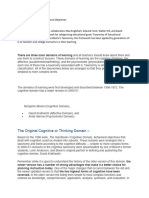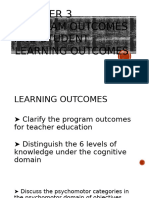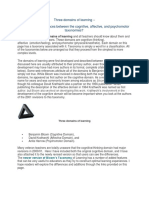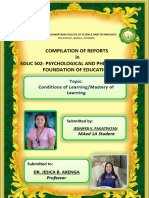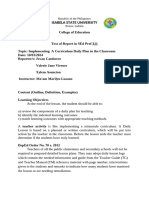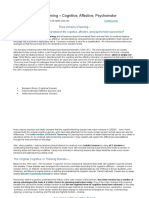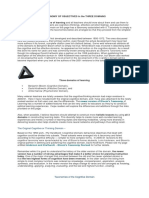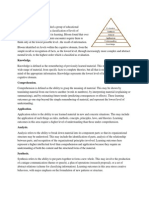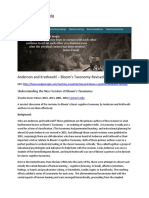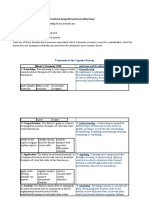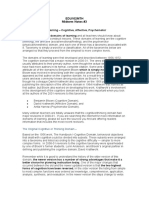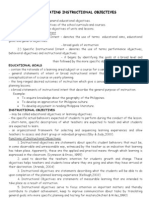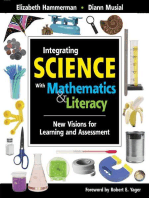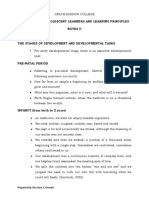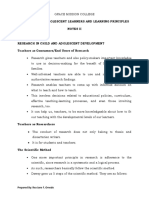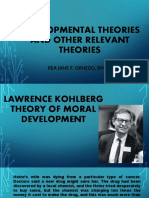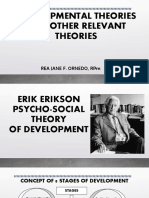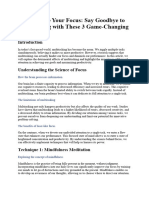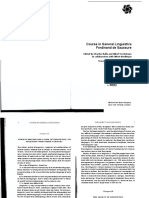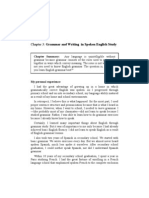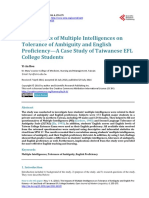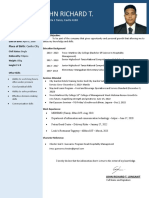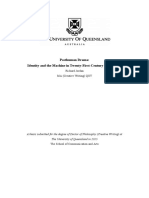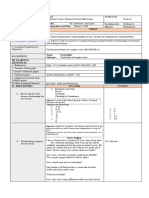Assessment in Learning 1-Module 3
Assessment in Learning 1-Module 3
Uploaded by
Rea Jane OrnedoCopyright:
Available Formats
Assessment in Learning 1-Module 3
Assessment in Learning 1-Module 3
Uploaded by
Rea Jane OrnedoCopyright
Available Formats
Share this document
Did you find this document useful?
Is this content inappropriate?
Copyright:
Available Formats
Assessment in Learning 1-Module 3
Assessment in Learning 1-Module 3
Uploaded by
Rea Jane OrnedoCopyright:
Available Formats
GRACE MISSION COLLEGE
ASSESSMENT LEARNING 1
NOTES III
April 25, 2022
PROGRAM OUTCOMES AND STUDENT LEARNING OUTCOMES
- The Commission on Higher Education, the body that regulates higher education
in the Philippines, I its Memorandum Order # 20, s 2014 requires the following
program outcomes for all higher education institutions the ability to:
a. Articulate and discuss the latest developments in the specific field of practice.
b. Effectively communicate orally and in writing using both English and Filipino;
c. Work effectively and independently in multi-disciplinary and multi-cultural teams;
d. Act in recognition of professional, social and ethnical responsibility; and
e. Preserve and promote “ Filipino historical and cultural heritage”
Some program outcomes are based on types of higher education institutional (HEI)
because this determines the focus and purpose of the HEI for example:
Graduates of professional institutions demonstrate a service orientation in one’s
profession.
Graduates of colleges participate in various types of employment, development
activities and public discourses, particularly in response to the needs of the
communities one serves.
Graduates of universities participate in the generation of new knowledge or in
research and development projects.
Graduates of State Universities and Colleges must, in addition, have the
competencies to support “national, regional and local development plans”.
PROGRAM OUTCOMES FOR TEACHER EDUCATION
The program outcomes specific to degrees are programs spelled out in the
specific Policies, Standards and Guidelines (PSG) per program or degree issued by the
same Commission. The following are the program outcomes for teacher education in
2017 Philippines.,
Prepared By: Rea Jane F. Ornedo
a. Articulate the rootedness of education in philosophical, socio-cultural, historical,
psychological and political contexts.
b. Demonstrates mastery of subject matter/discipline.
c. Facilitate learning using a wide range of teaching methodologies and delivery
mode appropriate to specific learner and their environments.
d. Develop innovative curricula, instructional plans, teaching approaches and
resources for diverse learners.
e. Apply skills in the development and utilization of ICT to promote quality, relevant
and sustainable educational practices.
f. Demonstrate a variety of thinking in planning, monitoring, assessing and
reporting learning process and outcomes.
g. Practice professional and ethical teaching standards sensitive to the local,
national and global realities.
h. Pursue lifelong learning for personal and professional growth through varied
experiential and field-based opportunities.
THE THREE TYPES OF LEARNING
- Benjamin Bloom and a committee if colleagues in 1956, believed that there were
more than one (1) type of learning.
- Bloom identified three domains of educational activities.
1. Cognitive- referring to mental skills
2. Affective-referring to growth in feeling or emotion
3. Psychomotor- referring to manual or physical skills.
- These terms were regarded as too technical by practicing teachers so the
domains were translated to simpler terms commonly used by teachers,
knowledge, skills and attitudes (KSA).
- These domains are organized into categories or levels and arranged in
hierarchical order from the simplest behavior to the most complex behavior.
Prepared By: Rea Jane F. Ornedo
BLOOM’S TAXONOMY 1956
1. KNOWLEDGE: Remembering or retrieving previously learned material.
- Examples of verbs that relate to these functions are:
Know identify relate list Define recall memorize Record name recognize
repeat acquire
2. COMPREHENSION: The ability to grasp or construct meaning from
material.
- Examples of verbs that relate to this function are:
Restate locate report identify discuss describe Illustrate interpret draw
recognize explain discuss review infer represent draw represent
express differentiate conclude.
3. APPLICATION: The ability to use learned material or to implement material
in new and concrete situations.
- Examples of verbs that relate to this function are:
Apply relate develop Organize employ Practice calculates show
translate use operate restructure interpret exhibit dramatize
demonstrate illustrate
4. ANALYSIS: The ability to break down or distinguish the parts of material
into its components so that its organizational structure may be better
understood.
- Examples of verbs that relate to this function are:
Analyze compare probe Differentiate contrast Experiment scrutinize
inquire examine contrast investigate detect survey discover inspect dissect
categorize classify deduce discriminate separate
Prepared By: Rea Jane F. Ornedo
5. SYNTHESIS: The ability to put parts together to form a coherent or unique
new whole.
- Examples of verbs that relate to this function are:
Compose produce design Plan invent formulate Propose develop arrange
assemble create prepare collect set up generalize construct organize
predict modify tell document combine relate originate derive write
propose
6. EVALUATION: The ability to judge, check, and even critique the value of
material for a given purpose
- Examples of verbs that relate to this function are:
Judge assess compare Argue decide choose rate Validate consider appraise
evaluate conclude select estimate value criticize infer
measure deduce
ANDERSON’S AND KRATHWOHL’S TAXONOMY 2001
1. REMEMBERING
- Recognizing or recalling knowledge from memory.
- Remembering is when memory is used to produce or retrieve definitions, facts, or
lists, or to recite previously learned information.
2. UNDERSTANDING
- Constructing meaning from different types of functions be they written or graphic
messages or activities like interpreting, exemplifying, classifying, summarizing,
inferring, comparing or explaining.
3. APPLYING
- Carrying out or using a procedure through executing or implementing.
- Applying related to or refers to situations where learned material is used through
products like models, presentations, interviews or simulations.
4. ANALYZING
- Breaking materials or concepts into parts, determining how the parts relate to
one another or how they interrelate or how the parts relate to an overall structure
or purpose.
Prepared By: Rea Jane F. Ornedo
- Mental actions included in this function are differentiating, organizing and
attributing, as well as being able to distinguish between the components or
parts.
- When one is analyzing, he/she can illustrate this mental function by creating
spreadsheets, surveys, charts or diagrams or graphic representations.
5. EVALUATING
- Making judgments based on criteria and standards through checking and
critiquing.
- Critiques, recommendations and reports are some of the products that can be
created to demonstrate the processes of evaluation.
- In the newer taxonomy, evaluating comes before creating as it is often a
necessary part of the precursory behavior before one creates something.
6. CREATING
- Putting elements together to form a coherent or functional whole; reorganizing
elements into a new pattern or structure through generating, planning or
producing.
- Creating requires users to put parts together in a new way, or synthesize parts
into something new and different creating a new form or product.
- This process is the most difficult mental function in the new taxonomy.
Prepared By: Rea Jane F. Ornedo
Bloom also identified specific types of knowledge as:
Terminology
Specific facts
Conventions
Trends and sequences
Classifications and categories
Criteria
Methodology
Principles and generalizations
Theories and structures
REVISED VERSION FORM ORIGINAL BY ANDERSON, L.W. AND KRATHWOHI
1. FACTUAL KNOWLEDGE
- As the name implies, this refers to facts.
- his refers to essential facts, terminology, details or elements students must know
or be familiar with in order to understand a discipline or solve a problem in it.
BASIC INFORMATION
Knowledge of terminology Vocabulary terms, mathematical symbols,
musical notation, alphabet
Knowledge of specific details and Components of the Food Pyramid, names
elements of congressional representatives
2. CONCEPTUAL KNOWLEDGE
- This refers to the interrelationship of facts.
- It is the facts put together within a larger
structunnnnnnnnnnnnnnnnnnnnnnnnnnnnnnnnnnnnnnre that enable them to
function together.
- It is knowledge of classifications, principles, generalizations, theories, models or
structures pertinent to a particular disciplinary area.
Prepared By: Rea Jane F. Ornedo
THE RELATIONSHIP AMONG PIECES OF A LARGER STRUCTURE THAT MAKE
THEM FUNCTION TOGETHER
Knowledge of classifications and Species of animals, different, kinds of
categories arguments, geological era
Knowledge of principles and Types of conflict in literature, Newton’s
generalizations Laws of Motion, principles of democracy
Knowledge of theories, models and Theory of evolution, economic theories,
structures DNA models
3. PROCEDURAL KNOWLEDGE
- This is knowing how to do something, refers to information or knowledge that
helps students to do something specific to a discipline, subject or area of study.
- It includes knowledge of methods of inquiry, criteria for using skills, algorithms,
techniques and methods.
HOW TO DO SOMETHING
Knowledge of subject-specific skills and Procedure for solving quadratic
algorithms equations, mixing colors for oil painting,
serving a volleyball
Knowledge of subject-specific techniques Literary criticism, analysis of historical
and methods documents, mathematical problem-
solving methods.
Knowledge of criteria for determining Methods appropriate for different kinds of
when to use appropriate procedures experiment, statistical analysis
procedures used for different situations,
syllabus guidelines for different genres of
writing
Prepared By: Rea Jane F. Ornedo
4. METACOGNITIVE KNOWLEDGE
- This is knowing that you know.
- This is thinking about your own thinking in a purposeful way.
- It is awareness and knowledge of one’s own cognition.
- It is reflective knowledge about how to go about solving problems and cognitive
task.
- It concludes contextual and conditional knowledge and knowledge self.
KNOWLEDGE OF THINKING IN GENERAL AND YOUR THINKING IN PARTICULAR
Strategic knowledge Ways of memorizing facts, reading
comprehension strategies, methods of
planning a Web site
Knowledge about cognitive tasks, Different reading demands of textbooks
including appropriate contextual and and novels; thinking ahead when using
conditional knowledge an electronic database; difference
between writing emails and writing
business letters.
Self-knowledge Need for a diagram or chart to
understand complex processes, better
comprehension in quiet environments,
need to discuss ideas with someone
before writing an essay.
Prepared By: Rea Jane F. Ornedo
EXAMPLES OF COGNITIVE ACTIVITIES
Prepared By: Rea Jane F. Ornedo
Prepared By: Rea Jane F. Ornedo
Prepared By: Rea Jane F. Ornedo
Prepared By: Rea Jane F. Ornedo
Prepared By: Rea Jane F. Ornedo
Prepared By: Rea Jane F. Ornedo
“The roots of education are bitter, but the fruit is sweet”-
Aristotle
Study well!!!! <3
Prepared By: Rea Jane F. Ornedo
You might also like
- Wheeler A DISCOURSE OF WONDERS PDFDocument145 pagesWheeler A DISCOURSE OF WONDERS PDFSamael Zeid100% (2)
- Speak Your Mind Student S Book Level Starter Unit 2 SpreadDocument7 pagesSpeak Your Mind Student S Book Level Starter Unit 2 SpreadГалина ВовкNo ratings yet
- Bloom's Taxonomy Updated. Anderson and KrathwohlDocument8 pagesBloom's Taxonomy Updated. Anderson and Krathwohlrususilviu100% (1)
- Program Outcomes and Learning OutcomesDocument31 pagesProgram Outcomes and Learning OutcomesAs Yang100% (5)
- Taxonomy of Educational Objectives Handbook 1 Cognitive DomainDocument31 pagesTaxonomy of Educational Objectives Handbook 1 Cognitive DomainAliNo ratings yet
- ENS Constantine Soulef Boulmerka Tefl 1 ST Year LMD Lecture 1 Learning ObjectivesDocument14 pagesENS Constantine Soulef Boulmerka Tefl 1 ST Year LMD Lecture 1 Learning ObjectivesMohamed Tayeb SELT100% (2)
- Program Outcomes AND Student Learning Outcomes: Nasol Ardivilla Moreno ORO UYDocument15 pagesProgram Outcomes AND Student Learning Outcomes: Nasol Ardivilla Moreno ORO UYMerlie MorenoNo ratings yet
- Program Outcomes and Student Learning OutcomesDocument20 pagesProgram Outcomes and Student Learning Outcomesserenity takumiNo ratings yet
- PED 8 - Hand-Outs Week 3Document4 pagesPED 8 - Hand-Outs Week 3John paul CabatanaNo ratings yet
- Educ. 105 Assessment of Learning 1 Module 2Document19 pagesEduc. 105 Assessment of Learning 1 Module 2Cristine BucaoNo ratings yet
- Educ-3-Module 9Document7 pagesEduc-3-Module 9Asuna SanNo ratings yet
- Taxonomy of EducationDocument7 pagesTaxonomy of Educationasiyaasghar313No ratings yet
- Chapter 2 BEED 2BDocument41 pagesChapter 2 BEED 2BFatima Erica SaningNo ratings yet
- Chapter 3 Assessment 2.0Document36 pagesChapter 3 Assessment 2.0patinofehbbygeanNo ratings yet
- Eced22 ReportDocument4 pagesEced22 ReportTilos CherithNo ratings yet
- Three Domains of LearningDocument14 pagesThree Domains of LearningaizaNo ratings yet
- 8628 2Document11 pages8628 2gulzar ahmadNo ratings yet
- Three Domains of LearningDocument12 pagesThree Domains of Learningrona labaydanNo ratings yet
- Instructional Objectives NotesDocument6 pagesInstructional Objectives NotesMaurice Nyamoti67% (3)
- Asdulo - Ped 109 032617Document24 pagesAsdulo - Ped 109 032617Norielle Ann Antong JuridicoNo ratings yet
- Assessment in Education IumDocument126 pagesAssessment in Education Iumkorneliaangula72No ratings yet
- Three Domains of LearningDocument10 pagesThree Domains of LearningFlorina Nadorra RamosNo ratings yet
- Cognitive Domain-Arlie G. FresnidoDocument29 pagesCognitive Domain-Arlie G. FresnidoArlie Gelua FresnidoNo ratings yet
- Activity On Learning ObjectivesDocument12 pagesActivity On Learning ObjectivesEdel Guyuran VillanuevaNo ratings yet
- Bloom Vs AndersonDocument6 pagesBloom Vs AndersonArdaniah Mufti IINo ratings yet
- Learning Sheet No. 2Document4 pagesLearning Sheet No. 2sermietokeilaNo ratings yet
- Domains of LearningDocument6 pagesDomains of Learningkidusyosef581No ratings yet
- Assessment in Learning 1 Lesson 4: Assessing Learning OutcomesDocument6 pagesAssessment in Learning 1 Lesson 4: Assessing Learning OutcomesReynante Louis DedaceNo ratings yet
- PDF 20230515 191118 0000Document19 pagesPDF 20230515 191118 0000Dummy AccountNo ratings yet
- Creating ObjectivesDocument7 pagesCreating ObjectivesMark BantaNo ratings yet
- G3 Program Outcome and Student Learnng Outcome.Document42 pagesG3 Program Outcome and Student Learnng Outcome.analynsabodNo ratings yet
- EDB1202 Blooms TaxonomyDocument22 pagesEDB1202 Blooms TaxonomyTukamushaba BismarkNo ratings yet
- Three Domains of LearningDocument6 pagesThree Domains of LearningrollramsNo ratings yet
- Teching and LearningDocument58 pagesTeching and LearningphaniezaongoNo ratings yet
- Three Domains of LearningDocument24 pagesThree Domains of LearningtamanimoNo ratings yet
- Bloom's of TaxonomyDocument24 pagesBloom's of TaxonomyMelinda Cariño ChavezNo ratings yet
- Field Study 2 MODULE 1Document14 pagesField Study 2 MODULE 1Princess Sabrina Pasillao BandarlipeNo ratings yet
- CONDITION OF LEARNING & MASTERY of LEARNING - JENNIFER V. PAGATPATANDocument9 pagesCONDITION OF LEARNING & MASTERY of LEARNING - JENNIFER V. PAGATPATANJennifer PagatpatanNo ratings yet
- Lesson 2: Implementing A Curriculum Daily in The Classrooms: Presented By: Elaine R. Mateo Bsed Iii-EnglishDocument41 pagesLesson 2: Implementing A Curriculum Daily in The Classrooms: Presented By: Elaine R. Mateo Bsed Iii-EnglishAlyssa AlbertoNo ratings yet
- The Three Types of LearningDocument5 pagesThe Three Types of LearningJonah A. RecioNo ratings yet
- Tor 311Document6 pagesTor 311Apple jane ValdezNo ratings yet
- Three Domains of Learning - Cognitive, Affective, PsychomotorDocument11 pagesThree Domains of Learning - Cognitive, Affective, PsychomotorRoselie Manansala CastilloNo ratings yet
- Blooms Revised Taxonomy Group6Document14 pagesBlooms Revised Taxonomy Group6Irees RaiNo ratings yet
- Three Domains of LearningDocument5 pagesThree Domains of LearningPam MendiolaNo ratings yet
- Chapter 3: Components of Curriculum Intended Learning OutcomesDocument12 pagesChapter 3: Components of Curriculum Intended Learning OutcomesJenny Rose MonzonNo ratings yet
- Chapter 3 Module 4 Lesson 2 Implementing...Document9 pagesChapter 3 Module 4 Lesson 2 Implementing...Jeru ElbanbuenaNo ratings yet
- BloomsDocument6 pagesBloomsmjacquinetNo ratings yet
- Organizing, and Attributing, As Well Between The Components or PartsDocument12 pagesOrganizing, and Attributing, As Well Between The Components or PartsAnonymous W18T7kcC9nNo ratings yet
- 3 Program Outcomes and Learning OutcomesDocument13 pages3 Program Outcomes and Learning OutcomesVanessa DacumosNo ratings yet
- Balanquit, Jennifer A. - Bocobo - Activity #4Document6 pagesBalanquit, Jennifer A. - Bocobo - Activity #4Jen Espina100% (2)
- Blooms Taxonomy RevisedDocument8 pagesBlooms Taxonomy RevisedEmmylou Molito PesidasNo ratings yet
- Discourse and ClassroomDocument12 pagesDiscourse and ClassroomAdam AdiyatmaNo ratings yet
- Three Domains of LearningDocument7 pagesThree Domains of LearningMelNo ratings yet
- Spec 11 Beed II-wps OfficeDocument6 pagesSpec 11 Beed II-wps OfficeAvyanna XyrelleNo ratings yet
- Domains of LearningDocument8 pagesDomains of LearningantonyNo ratings yet
- Ho m17 Prof-Pot Calamlam Prof-Pot Principles of TeachingDocument14 pagesHo m17 Prof-Pot Calamlam Prof-Pot Principles of Teachingjane malayangNo ratings yet
- EDU102MTH Midterm Notes #3: The Original Cognitive or Thinking DomainDocument6 pagesEDU102MTH Midterm Notes #3: The Original Cognitive or Thinking DomainsydneyNo ratings yet
- Instructional ObjectivesDocument5 pagesInstructional ObjectivesRoderick Gatdula100% (5)
- Integrating Science with Mathematics & Literacy: New Visions for Learning and AssessmentFrom EverandIntegrating Science with Mathematics & Literacy: New Visions for Learning and AssessmentNo ratings yet
- Essential Studying Tips to Excel in Math and Science CoursesFrom EverandEssential Studying Tips to Excel in Math and Science CoursesRating: 5 out of 5 stars5/5 (1)
- Assessment in Learning 1-Module 4Document8 pagesAssessment in Learning 1-Module 4Rea Jane OrnedoNo ratings yet
- Assessment in Learning 1-Module 5Document9 pagesAssessment in Learning 1-Module 5Rea Jane OrnedoNo ratings yet
- Module 2the Child and Adolescent Learners and Learning PrinciplesDocument6 pagesModule 2the Child and Adolescent Learners and Learning PrinciplesRea Jane OrnedoNo ratings yet
- Assessment in Learning 1-Module 2Document6 pagesAssessment in Learning 1-Module 2Rea Jane OrnedoNo ratings yet
- Module 3 The Child and Adolescent Learners and Learning PrinciplesDocument14 pagesModule 3 The Child and Adolescent Learners and Learning PrinciplesRea Jane OrnedoNo ratings yet
- 4 LAWRENCE KOHLBERG Theory of Moral DevelopmentDocument13 pages4 LAWRENCE KOHLBERG Theory of Moral DevelopmentRea Jane OrnedoNo ratings yet
- The Child and Adolescent Learners and Learning Principles Module 1Document13 pagesThe Child and Adolescent Learners and Learning Principles Module 1Rea Jane Ornedo100% (1)
- 3 ERIK ERIKSON Psychosocial Theory of DevelopmentDocument13 pages3 ERIK ERIKSON Psychosocial Theory of DevelopmentRea Jane OrnedoNo ratings yet
- JEAN PIAGET Cognitive Theory of DevelopmentDocument17 pagesJEAN PIAGET Cognitive Theory of DevelopmentRea Jane OrnedoNo ratings yet
- Supercharge Your FocusDocument5 pagesSupercharge Your FocusyohanbdmNo ratings yet
- DeSaussure Course Excerpts PDFDocument17 pagesDeSaussure Course Excerpts PDFOmar ShahidNo ratings yet
- G11SLM6 Q1Oral Com Final For TeacherDocument26 pagesG11SLM6 Q1Oral Com Final For TeacherJade BalbuenaNo ratings yet
- Faxoc JOB DESCRIPTION MachineLearningDocument1 pageFaxoc JOB DESCRIPTION MachineLearningKrishna KishoreNo ratings yet
- RHEA M. ENGAY-INDIVIDUAL-DAILY-LOG-AND-ACCOMPLISHMENT-REPORT-January-2022Document8 pagesRHEA M. ENGAY-INDIVIDUAL-DAILY-LOG-AND-ACCOMPLISHMENT-REPORT-January-2022rhea engayNo ratings yet
- Finding Answers Through Data CollectionDocument29 pagesFinding Answers Through Data CollectionGeazelle Xiandra GallegoNo ratings yet
- Building and Enhancing New Literacies Across The CurriculumDocument2 pagesBuilding and Enhancing New Literacies Across The CurriculumElmer Pajarito Belarmino88% (32)
- Advertising Chapter 4Document22 pagesAdvertising Chapter 4dindo monilNo ratings yet
- Chapter 3Document4 pagesChapter 3anon-341807No ratings yet
- Affect-Adaptive Activities in A PersonalisedDocument21 pagesAffect-Adaptive Activities in A PersonalisedreymertaNo ratings yet
- Adjectives WorksheetDocument4 pagesAdjectives WorksheetindiNo ratings yet
- Adjective ModifierDocument3 pagesAdjective ModifierHara DoNo ratings yet
- Exploring The Complex Relations Between Achievement Emotions and Self-Regulated Learning Behaviors in Online LearningDocument6 pagesExploring The Complex Relations Between Achievement Emotions and Self-Regulated Learning Behaviors in Online Learningapi-256237471No ratings yet
- Linguistics Cours 1st YearDocument74 pagesLinguistics Cours 1st YearKhadidja Belaskri83% (6)
- Maths Assignment 2Document16 pagesMaths Assignment 2api-361487933No ratings yet
- Business English Needs AnalysisDocument1 pageBusiness English Needs AnalysisarifsahidNo ratings yet
- Correlation Among Multiple Intelligences, Ambiguity Tolerance and English PDFDocument22 pagesCorrelation Among Multiple Intelligences, Ambiguity Tolerance and English PDFAmal DhainyNo ratings yet
- Ecological - Docouto2014Document7 pagesEcological - Docouto2014Arsip MahasiswaNo ratings yet
- Culture of Supervision NewsDocument2 pagesCulture of Supervision NewsMACARTHY MALANESNo ratings yet
- Critical Reasoning and Communication SkillsDocument195 pagesCritical Reasoning and Communication Skillsgpveetil83% (6)
- The Van Hiele Model of Geometric Thought1Document29 pagesThe Van Hiele Model of Geometric Thought1api-3732710100% (1)
- World English 3e Level 1 Grammar Activities Unit 6 Lesson ADocument1 pageWorld English 3e Level 1 Grammar Activities Unit 6 Lesson AHeber Mamani RamosNo ratings yet
- Richard Reume 2Document1 pageRichard Reume 2Richard LongakitNo ratings yet
- ENT PS Unit1 Lesson1 FinalDocument31 pagesENT PS Unit1 Lesson1 FinalAnne MoralesNo ratings yet
- PostHuman Drama Thesis PDFDocument220 pagesPostHuman Drama Thesis PDFFernando GarciaNo ratings yet
- Relative ClausesDocument13 pagesRelative ClausesAnna_MasalioNo ratings yet
- ProbabilityDocument5 pagesProbabilityCatherine SantiagoNo ratings yet
- Verb Form: Complete With The Missing - Use The PastDocument1 pageVerb Form: Complete With The Missing - Use The PastJesusito Maz Na Sin ApellidosNo ratings yet












